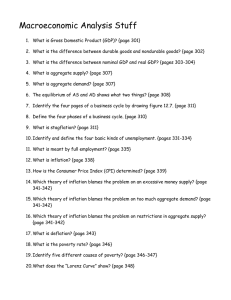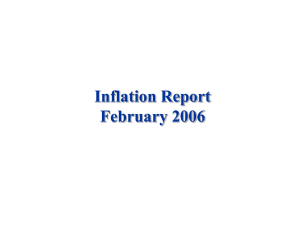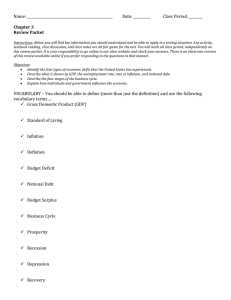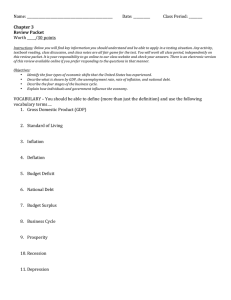Inflation Report May 2006
advertisement
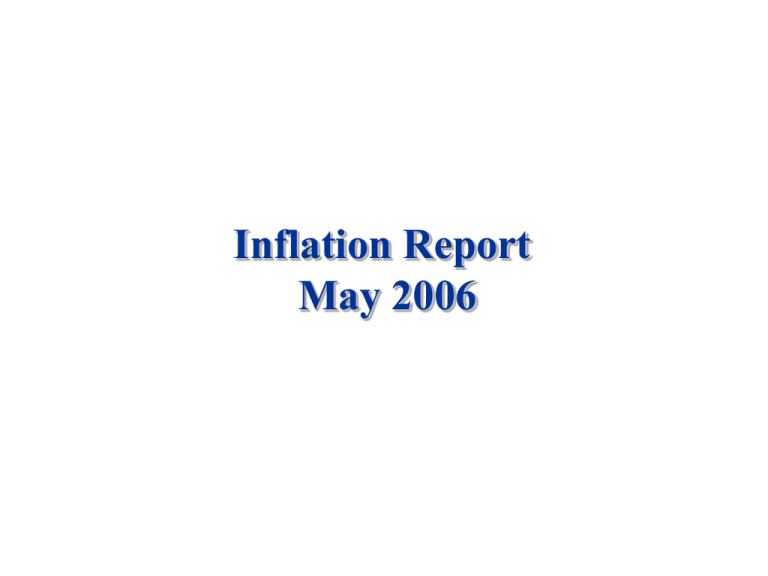
Inflation Report May 2006 Prospects for inflation Chart 5.1 Current GDP projection based on market interest rate expectations The fan chart depicts the probability of various outcomes for GDP growth in the future. If economic circumstances identical to today’s were to prevail on 100 occasions, the MPC’s best collective judgement is that GDP growth over the subsequent three years would lie within the darkest central band on only 10 of those occasions. The fan chart is constructed so that outturns of GDP growth are also expected to lie within each pair of the lighter green areas on 10 occasions. Consequently, GDP growth is expected to lie somewhere within the entire fan chart on 90 out of 100 occasions. The bands widen as the time horizon is extended, indicating the increasing uncertainty about outcomes. See the box on pages 48–49 of the May 2002 Inflation Report for a fuller description of the fan chart and what it represents. The dashed line is drawn at the two-year point. Chart 5.2 The MPC’s expectations for GDP growth based on market interest rate expectations(a) (a) These figures are derived from the same distribution as Chart 5.1. They represent the probabilities that the MPC assigns to GDP growth lying within a particular range at a specified time in the future. Chart 5.3 Current CPI inflation projection based on market interest rate expectations Chart 5.4 CPI inflation projection in February based on market interest rate expectations The fan charts depict the probability of various outcomes for CPI inflation in the future. If economic circumstances identical to today’s were to prevail on 100 occasions, the MPC’s best collective judgement is that inflation over the subsequent three years would lie within the darkest central band on only 10 of those occasions. The fan charts are constructed so that outturns of inflation are also expected to lie within each pair of the lighter red areas on 10 occasions. Consequently, inflation is expected to lie somewhere within the entire fan charts on 90 out of 100 occasions. The bands widen as the time horizon is extended, indicating the increasing uncertainty about outcomes. See the box on pages 48–49 of the May 2002 Inflation Report for a fuller description of the fan chart and what it represents. The dashed lines are drawn at the respective two-year points. Chart 5.5 The MPC’s expectations for CPI inflation based on market interest rate expectations(a) (a) These figures are derived from the same distribution as Chart 5.3. They represent the probabilities that the MPC assigns to CPI inflation lying within a particular range at a specified time in the future. Chart 5.6 Current projection for CPI inflation in 2008 Q2(a) based on market interest rate expectations Chart 5.7 February projection for CPI inflation in 2008 Q2(a) based on market interest rate expectations (a) These charts represent a cross-section of the respective fan charts in 2008 Q2 for the market interest rate projections. The coloured bands have a similar interpretation to those on the fan charts. The fan chart widens as the time horizon is extended. 2008 Q2 is nearer to the starting point in the current projection than it was in February so, for a given degree of uncertainty and balance of risks, the spread of possible outcomes in that quarter would tend to be narrower in Chart 5.6 than in Chart 5.7. (b) Probability of inflation being within ±0.05 percentage points of any given inflation rate, specified to one decimal place. For example, the probability of inflation being 2.0% (between 1.95% and 2.05%) in the current projection is around 7%. Chart 5.8 Current GDP projection based on constant nominal interest rates at 4.5% See footnote to Chart 5.1. Chart 5.9 Current CPI inflation projection based on constant nominal interest rates at 4.5% See footnote to Charts 5.3 and 5.4. Asset price assumptions Chart A Market beliefs about future interest rates The mean of the fan chart is the market rate profile for the fifteen-day average ending 3 May, consistent with the measure of interest rates shown in Table 1. The distribution is derived using the prices of options on threemonth Libor futures contracts traded on Euronext.liffe. It is constructed by averaging the daily distributions around a common mean for each of the fifteen days. The average is calculated for each probability band at each quarter. The fan chart depicts the probability of outcomes for interest rates in the future. It has a similar interpretation to the fan charts in the Overview and in this section of the Report. The chart is only indicative of market expectations of future policy rates as it is based on Libor instruments, and is estimated on the assumption that investors are risk-neutral. Table 1 Expectations of the Bank’s official interest rate implied by market yields(a) Per cent May 2006 Q2 Q3 Q4 2007 Q1 Q2 4.5 4.5 Q4 2008 Q1 Q2 Q3 Q4 2009 Q1 Q2 Q3 4.6 4.6 4.7 4.8 4.8 4.9 4.9 4.9 4.9 4.8 4.8 2006 Q2 Q3 Q4 2007 Q1 Q2 Q3 Q4 2008 Q1 Q2 Q3 Q4 2009 Q1 4.4 4.4 4.4 4.4 4.5 4.5 4.5 4.5 4.5 4.5 4.5 4.4 February (a) The data are fifteen-day averages of one-day forward rates to 3 May 2006 and 8 February 2006 respectively. They have been derived from instruments that settle on the London interbank offered rate. That includes the market rates on futures, swaps, interbank loans and forward rate agreements, adjusted for credit risk. The MPC may change the way it estimates these expectations from time to time, as shifting market conditions can alter the relative advantages of using different methods. Other forecasters’ expectations Chart A Distribution of CPI inflation forecasts for 2008 Q2 Source: Central projections of 24 outside forecasters as of 26 April 2006. Table 1 Average of other forecasters’ projections of CPI inflation, GDP growth, interest rates and the ERI(a) 2006 Q1(b) CPI inflation(c) 1.9 GDP growth(c) 2.2 Official rate (per cent) 4.5 Sterling ERI(d) 98.9 (New index: January 2005 = 100) 2007 Q2 2008 Q2 2009 Q2 1.9 2.4 4.4 97.0 1.9 2.6 4.6 96.1 1.9 2.5 4.5 96.2 Sources: Bank of England, ONS and central projections of outside forecasters as of 26 April 2006. (a) For 2007 Q2, 27 forecasters provided the Bank with forecasts for CPI inflation, GDP growth and the official rate. For 2008 Q2, there were 24 forecasts in each case. For 2009 Q2, there were 23 forecasts for CPI inflation and GDP growth, and 22 for the official rate. For the sterling ERI, there were 23 forecasts for 2007 Q2, and 19 for 2008 Q2 and 2009 Q2. (b) Outturns. GDP is the preliminary ONS estimate for chained volume GDP at market prices. The official rate and sterling ERI are averages of daily values. (c) Four-quarter percentage changes. (d) Where necessary, responses were adjusted to take account of the difference between the old and new ERI measures, based on the comparative outturns for 2006 Q1. Table 2 Other forecasters’ probability distributions for prospective CPI inflation and GDP growth(a) CPI inflation Probability, per cent(b) 2007 Q2 2008 Q2 2009 Q2 Range: Less than 1.0% 1.0% to 1.5% 1.5% to 2.0% 2.0% to 2.5% 2.5% to 3.0% More than 3.0% 2 5 7 14 14 14 41 38 36 30 28 28 10 11 11 3 4 5 Range: Less than 1% 1% to 2% 2% to 3% More than 3% 4 7 8 28 27 27 53 47 44 15 19 21 GDP growth Probability, per cent(b) 2007 Q2 2008 Q2 2009 Q2 Source: Projections of outside forecasters as of 26 April 2006. (a) For 2007 Q2, 26 forecasters provided the Bank with their assessment of the likelihood of expected twelve-month CPI inflation and four-quarter GDP growth falling in the ranges shown above. For 2008 Q2, this was provided by 23 forecasters. For 2009 Q2, there were 22. The table shows the average probabilities across respondents: for example, on average forecasters assigned a probability of 57% to CPI inflation turning out to be 2.0% or less in 2008 Q2. (b) Figures may not sum to 100 due to rounding.
